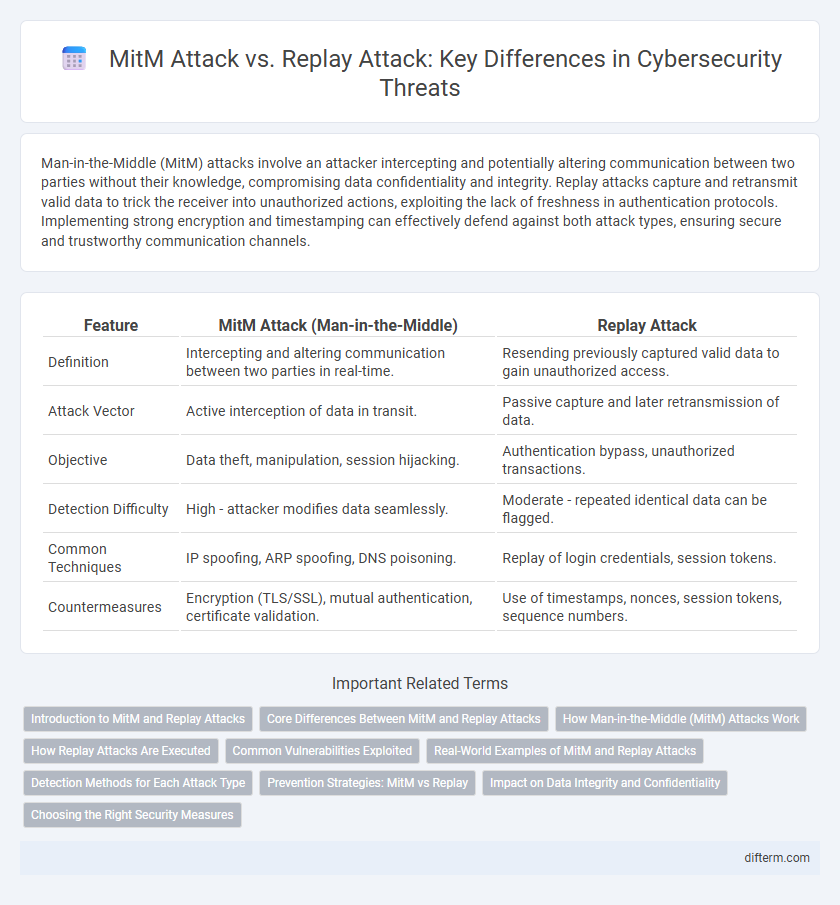Man-in-the-Middle (MitM) attacks involve an attacker intercepting and potentially altering communication between two parties without their knowledge, compromising data confidentiality and integrity. Replay attacks capture and retransmit valid data to trick the receiver into unauthorized actions, exploiting the lack of freshness in authentication protocols. Implementing strong encryption and timestamping can effectively defend against both attack types, ensuring secure and trustworthy communication channels.
Table of Comparison
| Feature | MitM Attack (Man-in-the-Middle) | Replay Attack |
|---|---|---|
| Definition | Intercepting and altering communication between two parties in real-time. | Resending previously captured valid data to gain unauthorized access. |
| Attack Vector | Active interception of data in transit. | Passive capture and later retransmission of data. |
| Objective | Data theft, manipulation, session hijacking. | Authentication bypass, unauthorized transactions. |
| Detection Difficulty | High - attacker modifies data seamlessly. | Moderate - repeated identical data can be flagged. |
| Common Techniques | IP spoofing, ARP spoofing, DNS poisoning. | Replay of login credentials, session tokens. |
| Countermeasures | Encryption (TLS/SSL), mutual authentication, certificate validation. | Use of timestamps, nonces, session tokens, sequence numbers. |
Introduction to MitM and Replay Attacks
Man-in-the-Middle (MitM) attacks involve an attacker secretly intercepting and potentially altering communication between two parties without their knowledge, compromising confidentiality and integrity. Replay attacks occur when an attacker captures valid data transmissions and fraudulently retransmits them to gain unauthorized access or deceive the receiver. Both attacks exploit weaknesses in communication protocols, emphasizing the need for robust encryption and authentication mechanisms to prevent unauthorized interception and data reuse.
Core Differences Between MitM and Replay Attacks
A Man-in-the-Middle (MitM) attack intercepts and alters communication between two parties in real-time, enabling attackers to eavesdrop or manipulate data. In contrast, a Replay Attack involves capturing valid data transmissions and retransmitting them later to deceive the recipient without altering the original message content. The core difference lies in MitM's active interference during communication versus Replay Attack's passive reuse of captured data to gain unauthorized access or privileges.
How Man-in-the-Middle (MitM) Attacks Work
Man-in-the-Middle (MitM) attacks intercept and alter communication between two parties without their knowledge, allowing attackers to eavesdrop, steal data, or inject malicious content. Attackers position themselves between the client and server, often exploiting insecure networks or vulnerabilities in protocols like HTTP or Wi-Fi connections. Encryption protocols such as TLS and mutual authentication mechanisms are critical defenses against MitM attacks.
How Replay Attacks Are Executed
Replay attacks are executed by intercepting valid data transmissions and then retransmitting them to gain unauthorized access or duplicate transactions. Attackers capture authentication tokens or session credentials during communication and reuse these captured messages to impersonate legitimate users. This exploit bypasses typical security measures by exploiting the lack of freshness verification, such as timestamps or nonces, in the communication protocol.
Common Vulnerabilities Exploited
Man-in-the-Middle (MitM) attacks and Replay attacks exploit overlapping vulnerabilities such as insecure communication channels and weak authentication mechanisms. MitM attacks leverage interception and alteration of data packets in transit, often targeting protocols without strong encryption like HTTP or outdated SSL/TLS versions. Replay attacks exploit lack of nonce or timestamp usage, enabling attackers to resend valid data transmissions repeatedly to gain unauthorized access or manipulate system states.
Real-World Examples of MitM and Replay Attacks
The 2011 DigiNotar breach exemplifies a MitM attack where attackers issued bogus security certificates, intercepting and decrypting secure communications on government websites. In contrast, the 2014 Target data breach involved a replay attack, where hackers reused stolen credentials to access secure systems and exfiltrate customer payment information. These incidents highlight the critical need for robust encryption and multi-factor authentication in mitigating MitM and replay attack risks.
Detection Methods for Each Attack Type
MitM attack detection relies on monitoring unusual network traffic patterns and validating digital certificates through certificate pinning to identify unauthorized interception. Replay attack detection involves timestamping and sequence number verification to recognize repeated or delayed packets that indicate message retransmission. Intrusion detection systems (IDS) use behavior analysis and anomaly detection tailored to each attack type, enhancing real-time threat identification and mitigation.
Prevention Strategies: MitM vs Replay
MitM attack prevention relies on robust encryption protocols like TLS and mutual authentication to ensure secure communication channels and verify identities. Replay attack prevention focuses on implementing nonce values, timestamps, and sequence numbers to detect and reject duplicated or delayed messages. Employing both sets of strategies strengthens overall network security by protecting data integrity and confidentiality against interception and unauthorized retransmission.
Impact on Data Integrity and Confidentiality
Man-in-the-Middle (MitM) attacks compromise data confidentiality by intercepting and altering communications in real time, allowing attackers to manipulate or steal sensitive information without detection. Replay attacks primarily threaten data integrity by resending captured valid data packets, potentially causing unauthorized actions without changing the original content. Both attack types undermine secure communication protocols, making robust encryption and authentication mechanisms essential for protecting data integrity and confidentiality.
Choosing the Right Security Measures
MitM attacks intercept and alter communications in real-time, requiring encryption protocols such as TLS and certificate pinning to ensure data integrity and confidentiality. Replay attacks involve capturing valid data transmissions and retransmitting them later, best mitigated by implementing nonce values, timestamps, and session tokens to prevent unauthorized reuse. Selecting security measures tailored to the attack vector enhances protection against unauthorized access and data breaches in network communications.
MitM Attack vs Replay Attack Infographic

 difterm.com
difterm.com